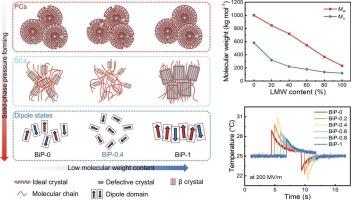Geometric mismatch of chain lengths enhancing the electrocaloric effect in PVDF
IF 13.2
1区 工程技术
Q1 ENGINEERING, CHEMICAL
引用次数: 0
Abstract
Poly(vinylidene fluoride) (PVDF) is a promising candidate for solid-state cooling due to its excellent dielectric properties, flexibility, and processability. However, achieving significant enhancement in its electrocaloric effect (ECE) remains a challenge. Here, a bimodal molecular weight distribution (MWD) system is constructed by blending PVDFs of high and low molecular weights, introducing geometric mismatches that promote defective crystalline regions and weaken dipole coupling. Multi-scale structural analysis using two-dimensional polarized infrared spectroscopy and X-ray diffraction reveals the orientation and stacking behavior of the secondary crystals (SCs). The broadened MWD facilitates the formation of smaller and looser dipolar domains, significantly improving dipole reversibility. The optimized PVDF film achieves a maximum ΔTECE of 4.3 K and ΔSECE of 78 J kg−1 K−1, representing ~330 % and ~ 360 % enhancements over the unimodal sample. This work underscores the critical significance of MWD-regulated SCs in enhancing electrocaloric performance, providing new insights into structural design strategies for solid-state cooling polymers.

链长几何错配增强了聚偏氟乙烯的热效应
聚偏氟乙烯(PVDF)由于其优异的介电性能、柔韧性和可加工性而成为固态冷却的有希望的候选者。然而,实现其电热效应(ECE)的显著增强仍然是一个挑战。在这里,通过混合高分子量和低分子量的pvdf构建了双峰分子量分布(MWD)体系,引入几何不匹配,促进缺陷晶体区域和减弱偶极子耦合。利用二维偏振红外光谱和x射线衍射的多尺度结构分析揭示了二次晶体(SCs)的取向和堆叠行为。扩大的随钻距离有利于形成更小、更松散的偶极畴,显著提高了偶极的可逆性。优化的PVDF膜达到最大ΔTECE 4.3 K和Δ为78 J 公斤−1 K−1,代表360年~ 330年 %和 ~ %增强单峰样本。这项工作强调了mwd调节的sc在提高电热性能方面的重要意义,为固态冷却聚合物的结构设计策略提供了新的见解。
本文章由计算机程序翻译,如有差异,请以英文原文为准。
求助全文
约1分钟内获得全文
求助全文
来源期刊

Chemical Engineering Journal
工程技术-工程:化工
CiteScore
21.70
自引率
9.30%
发文量
6781
审稿时长
2.4 months
期刊介绍:
The Chemical Engineering Journal is an international research journal that invites contributions of original and novel fundamental research. It aims to provide an international platform for presenting original fundamental research, interpretative reviews, and discussions on new developments in chemical engineering. The journal welcomes papers that describe novel theory and its practical application, as well as those that demonstrate the transfer of techniques from other disciplines. It also welcomes reports on carefully conducted experimental work that is soundly interpreted. The main focus of the journal is on original and rigorous research results that have broad significance. The Catalysis section within the Chemical Engineering Journal focuses specifically on Experimental and Theoretical studies in the fields of heterogeneous catalysis, molecular catalysis, and biocatalysis. These studies have industrial impact on various sectors such as chemicals, energy, materials, foods, healthcare, and environmental protection.
 求助内容:
求助内容: 应助结果提醒方式:
应助结果提醒方式:


